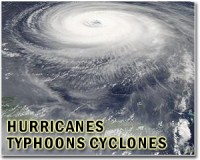 |
Arlington VA (SPX) Jul 30, 2010 Summer storms are a regular feature in the North Atlantic, and while most pose little threat to our shores, a choice few become devastating hurricanes. To decipher which storms could bring danger, and which will not, atmospheric scientists are heading to the tropics to observe these systems as they form and dissipate--or develop into hurricanes. By learning to identify which weather systems are the most critical to track, the efforts may ultimately allow for earlier hurricane prediction, and add several days to prepare for a hurricane's arrival. With primary support from NSF, the Pre-Depression Investigation of Cloud Systems in the Tropics (PREDICT) mission will run from August 15 to September 30, 2010, the height of hurricane season. Flying aboard the NSF/NCAR Gulfstream V (G-V) research aircraft, formerly known as HIAPER, researchers will make observations from close proximity, and above, storm systems. In addition to deploying dropsondes--parachute-borne instrument packages--the researchers will use remote sensing and cloud physics instruments to gather data on temperature, humidity, wind speed and direction, and characteristics of ice particles and their nuclei, which may include African dust. "We hope to test recently developed hypotheses about flow features of tropical waves that help distinguish which ones will develop into tropical storms," said Christopher Davis, of the NSF-sponsored National Center for Atmospheric Research (NCAR) and a principal investigator on the project. "These hypotheses require measurements across hundreds of miles, but with details in places down to one mile or so, and even less when we consider the ice particles themselves." The NSF/NCAR research team will coordinate their observations with two concurrent, but independent, missions in the region: the National Aeronautics and Space Administration (NASA) project known as GRIP (Genesis and Rapid Intensification Processes) and the National Oceanic and Atmospheric Administration (NOAA) IFEX (Intensity Forecasting Experiment). "The NSF/NCAR G-V offers us unprecedented capability to collect critical atmospheric measurements over regions far larger than has been practical for traditional 'lower-and-slower' turboprop hurricane-hunter aircraft," added Bradley Smull, NSF program director for Physical and Dynamic Meteorology. "The G-V will allow our investigators to sample the inner workings of a large number of towering tropical cloud systems, and ultimately to better discriminate those that will develop into full-blown hurricanes from those that will not."
Share This Article With Planet Earth
Related Links National Science Foundation Bringing Order To A World Of Disasters When the Earth Quakes A world of storm and tempest
 Typhoon Chanthu lashes flood-hit China
Typhoon Chanthu lashes flood-hit ChinaChongqing, China (AFP) July 22, 2010 Typhoon Chanthu lashed southern China with punishing winds and heavy rain on Thursday in the latest weather challenge for a country where flooding has killed 700 people this year. Chanthu made landfall in Guangdong province with winds of up to 126 kilometres an hour (78 mph) as the nation grapples with its worst flooding in 10 years, expected to continue as the typhoon season gains pace. ... read more |
|
| The content herein, unless otherwise known to be public domain, are Copyright 1995-2010 - SpaceDaily. AFP and UPI Wire Stories are copyright Agence France-Presse and United Press International. ESA Portal Reports are copyright European Space Agency. All NASA sourced material is public domain. Additional copyrights may apply in whole or part to other bona fide parties. Advertising does not imply endorsement,agreement or approval of any opinions, statements or information provided by SpaceDaily on any Web page published or hosted by SpaceDaily. Privacy Statement |